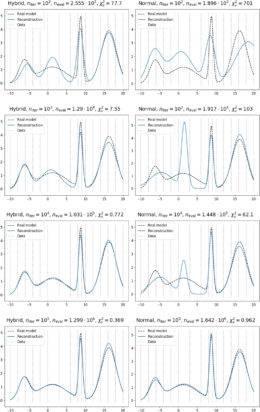Astronomy is driven forward by a combination of novel observations and complex, inventive modeling. How can astronomers better analyze their models? A new study presents a tool for the job — and is also the first article published under a new partnership between the American Astronomical Society (AAS) and the Journal of Open Source Software.
Exploring a Complex Universe
Modeling complicated astronomical systems is an important part of how we work to understand the universe. As technology advances, models have become increasingly more complex, encompassing more and more parameters. Complex models can do a better job of describing the astronomical systems we observe, but they’re also more challenging — and time-consuming — to analyze to see how well they might fit data.

Reconstruction of a multi-Gaussian model with 12 parameters using two techniques: normal MCMC parameter sampling (right column) and hybrid PRISM+MCMC parameter sampling (left column). The reconstruction is shown as a blue solid line, and the true model is shown as a dashed black line. The different rows represent increasing iterations. The hybrid reconstruction fits the known data better after fewer iterations — effectively analyzing the model 16 times faster than the normal MCMC approach. Click to enlarge. [van der Velden et al. 2019]
While MCMC methods are generally robust, they can be quite slow — you might spend a lot of time sampling uninteresting parts of parameter space rather than focusing on the ones that are most likely to describe your system. To address this problem, a team of scientists led by Ellert van der Velden (Swinburne University of Technology and ARC Centre of Excellence in All Sky Astrophysics, Australia) have developed a new tool: a software package they call Probabilistic Regression Instrument for Simulating Models, or PRISM.
Let’s Speed Up the Process
How does PRISM work? When given a model to analyze, PRISM uses clever statistical methods to create an approximation of the model and iteratively predict which regions of parameter space aren’t of interest. This allows the user to home in on the interesting regions and explore the general behavior of a model very quickly. This algorithm can be used either alone or in conjunction with MCMC methods to analyze models more efficiently.
PRISM’s approach isn’t new: these techniques have previously been used to analyze models in a variety of scientific disciplines, including the study of whales, oil reservoirs, galaxy formation, disease, and biological systems. But PRISM takes the techniques and neatly bundles them up into a python software package that anyone can use to analyze their models — a valuable tool for astronomers and other scientists alike!

The Journal of Open Source Software is a developer friendly, open access journal for research software packages. [JOSS]
A New Partnership for Software
Want more assurance about this software? You’ve got it! Van der Velden and collaborators’ article on PRISM, published in ApJS, is just one of a pair of publications; the second is the scrutinized software itself.
Under a new agreement between the AAS and the Journal of Open Source Software (JOSS), scientists submitting articles about astronomical software to AAS journals may choose not only to have their article reviewed, but also to have the software itself reviewed at JOSS in parallel. When both review processes are complete, the reviewed software is linked with the paper describing it in AAS journals.
The article presenting PRISM is the first of these simultaneous reviews to be conducted and published, and we expect many more to come! Software plays such an integral role in the study of astronomy today, and AAS publishing is pleased to help ensure that these valuable tools are shared.
Citation
“Model Dispersion with PRISM: An Alternative to MCMC for Rapid Analysis of Models,” Ellert van der Velden et al 2019 ApJS 242 22. doi:10.3847/1538-4365/ab1f7d
“Model dispersion with PRISM; an alternative to MCMC for rapid analysis of models,” van der Velden 2019 Journal of Open Source Software, 4(38) 1229. doi:10.21105/joss.01229
